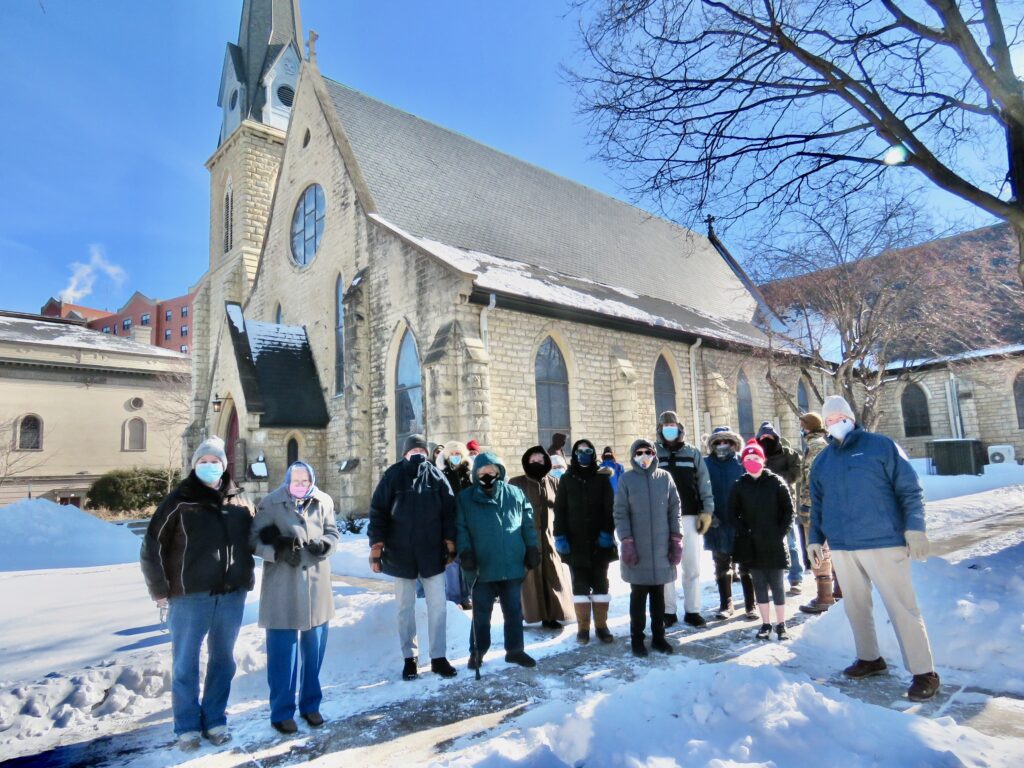Complex Conditions Challenge Church Creativity

A group of at least 25 bundled up and masked parishioners stood outside Christ Episcopal Church in Red Wing precisely at 11 a.m., February 7.
The temperature was -6 with a wind chill of -20.
What would drive anyone to do this? Well, it was not a church service. The gathering had to do with the church by-laws which require an in-person annual meeting, normally held in late January. Any resolutions brought forward are voted on at that meeting. This year’s meeting was held remotely via Zoom on January 31.
Because of the by-laws, an additional in-person meeting of at least a quorum was required to ratify the resolutions passed at the previous meeting. Since the church was closed due to the pandemic, it had to be held outdoors. But no one expected a polar vortex. The meeting, which lasted less than one minute, included just three votes – one to choose a clerk to record the meeting, one to collectively ratify all the previously passed resolutions and one to close the meeting.
As one might expect, one of the resolutions was to change the by-laws to allow for remote meetings if an in-person one is not feasible, such as during a pandemic.
On top of this, the outdoor meeting had been announced to start at 11 a.m. and the prerecorded Zoom service was scheduled for 10 a.m. That wouldn’t give people enough time to drive to church for the meeting after the service. Fortunately, this was realized before the service was recorded so it was shortened. The sermon was less than four minutes long.
Strategic Service Recordings
Because of strict pandemic rules from the Episcopal diocese regarding on-site church services, a group of 10 or 11 has been prerecording three services at a time. Two of us do the recording, three are clergy presenting the service, four or five make up the choir and we have an organist. Everyone is masked except for the choir which unmasks when they sing. They are strategically distanced no less than 14 feet from each other in the pews, each facing a single microphone in the aisle.
This has been quite an experience although we are getting better each session. We have learned to make sure the heat is on. One time we recorded at 49 degrees. You just can’t heat up a large church in 15 minutes. There has been some scrambling to change the scenery in the chancel when the church season changes between recordings. This can get even more complicated when services are recorded out of order because someone with a key role in one of them has to leave early.
We’ve had to stop and restart a few recordings because a microphone wasn’t on but we’ve been lucky that we haven’t had a major problem half-way through. We did lose the choir on the final hymn of one service. That’s when I learned that batteries for wireless microphones can’t be trusted to last for multiple recording sessions. Now it’s new batteries each time we meet.
This is how crazy things have gotten. We don’t expect to fully open the church for services until fall. For Ash Wednesday you can receive the Imposition of Ashes in front of the church at 5 p.m. and a drive-by option follows that.
Churches that are hosting in-person services have a lot to consider. The pandemic rules need to be monitored and, for many churches, the regular attendees are the same people most susceptible to the virus – the elderly and infirm. At least now you’d have a good excuse for sitting at the far end of the last pew.
The Patriotic Carillon
An aspect of Christ Church that most residents will recognize is the carillon that has for decades played the Westminster bells to toll the time on the quarter hour from 9 a.m. to 9 p.m. every day. I suppose it is in keeping with the church’s Anglican roots. It also plays randomly selected seasonal hymns at the significant business hours of 9 a.m., noon and 5 p.m.
How do I know all this? Because I’m the one who programs it. It’s really an honor, having grown up with its tolls and hymns. We’re on our third carillon, having migrated from an entirely mechanical European model to a digital hybrid system to a completely digital system.
The first system was donated and maintained by church member Gordon Lee, one of the founders of Central Research. His son, David Lee, managed the second system and I have maintained the current one for more than 10 years.
The carillon’s relevance to this discourse is that recently, due to the ongoing national political strife, someone suggested that we include a patriotic song in our recorded services. Our hymnal includes many. I suggested that I could program the carillon to play patriotic songs for the whole town. So that’s why you hear, for now at least, a patriotic song as the first song of each trilogy.
Initially, I programmed carefully chosen songs. The Battle Hymn of the Republic didn’t seem appropriate so soon after January 6 but I did program it to play the Star Spangled Banner as the first song every noon.
I have now set it to randomly play any of its patriotic songs at the appointed times. The thought of citizens coming to attention and placing a hand over their heart every day at 12 p.m. seemed a bit much.